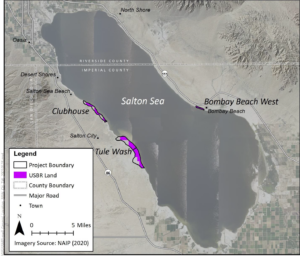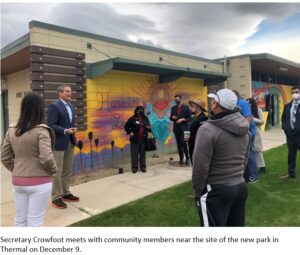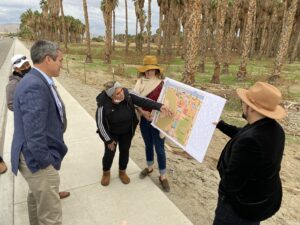Vegetation Enhancement Projects Moving Ahead in Partnership with U.S. Bureau of Reclamation
 The Salton Sea Management Program and U.S. Bureau of Reclamation (Reclamation) are partnering to establish about 1,700 acres of native vegetation enhancement projects around the Salton Sea on land owned by the Reclamation. The Vegetation Enhancement Projects aim to establish and enhance native vegetation on the exposed lakebed to create habitat benefits and provide suppression of wind-blown dust.
The Salton Sea Management Program and U.S. Bureau of Reclamation (Reclamation) are partnering to establish about 1,700 acres of native vegetation enhancement projects around the Salton Sea on land owned by the Reclamation. The Vegetation Enhancement Projects aim to establish and enhance native vegetation on the exposed lakebed to create habitat benefits and provide suppression of wind-blown dust.
The projects are planned at three different locations. Two sites are located near the community of Salton City: Clubhouse (approximately 400 acres) and Tule Wash (approximately 1,215 acres). The third site is located near the community of Bombay Beach (approximately 90 acres).
The specific objective of the projects is to enable the creation of an Iodine Bush vegetation community across the three sites. This vegetation community is dominated by Iodine Bush with other associated species, and is widely observed across the arid Southwestern U.S., especially in the vicinity of saline lakes. The vegetation is also widely observed around the perimeter of the Salton Sea.
The project will enhance the growth of existing vegetation stands and promote new growth in open areas. The treatment of existing vegetation stands will consist of weed removal and the addition of compost to promote growth. Open areas of the lakebed will be supplied with water, plants, seeds, and physical modifications to promote growth of native vegetation.
Three vegetation establishment methods are proposed, including natural recruitment, seeding, and planting. Vegetation in the form of seeding or planting (potted plants or plugs grown in a nursery) will be combined with wind protection such as straw bales and water to help protect and facilitate plant growth and improve plant survival rates. The mix of plant species to be considered for the project include Iodine Bush (Allenrolfea occidentalis), Big Saltbush (Atriplex lentiformis), Salton Saltbush (Atriplex canescens var. macllenta), Bush Seepweed (Sueda nigra), Western Sea-purslane (Sesuvium verrucosum), Cattle Saltbush (Atriplex polycarpa), and other opportunistic species.
The work is envisioned to begin this year and continue into 2023. Once established, these vegetated landscapes are expected to be sustained by natural water flows and precipitation resident to the area.
Salton Sea Region Receives $57 Million in State Funding for New and Revitalized Parks
 Communities in the Salton Sea region are receiving $57 million in grant funding for new and revitalized parks as part of the state’s largest-ever single investment in improving access to parks and open spaces.
Communities in the Salton Sea region are receiving $57 million in grant funding for new and revitalized parks as part of the state’s largest-ever single investment in improving access to parks and open spaces.
Awarded through the Statewide Park Development and Community Revitalization Grant Program, the grants will deliver six new parks in Imperial and Riverside Counties and revitalize two existing ones.
The competitive grant program is part of the Governor Newsom Administration’s “California Outdoors for All” initiative to expand equitable access to the outdoors in underserved communities across California.
New parks will be created in Calipatria, Heber, Cathedral City, Coachella, Indio, Thermal and Banning. Improvements will be made at Gomez Park in the City of El Centro. Renovations to Patterson Park in the City of Riverside are also funded.
“These funding awards are a huge deal for Californians. Creating new parks across the state – including in many communities currently without adequate outdoor public space – will make a real, lasting difference in the lives of young people and all residents,” said California Secretary for Natural Resources Wade Crowfoot. “It’s one more way the Governor and Legislature are working to improve the lives of all Californians.”
The Outdoors for All initiative is focused on equitably expanding outdoor access to all Californians through focused investments in open space infrastructure, outdoor programming, and improvements to state systems.

